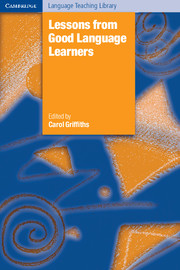Book contents
- Frontmatter
- Contents
- List of contributors
- Acknowledgements
- Editor's overview
- Prologue
- Reflections
- Part I Learner variables
- Part II Learning variables
- 12 Vocabulary and good language learners
- 13 Grammar and good language learners
- 14 Functions and good language learners
- 15 Pronunciation and good language learners
- 16 Listening and good language learners
- 17 Speaking and good language learners
- 18 Reading and good language learners
- 19 Writing and good language learners
- 20 Teaching/learning method and good language learners
- 21 Strategy instruction and good language learners
- 22 Errors correction and good language learners
- 23 Tasks and good language learners
- The learners' landscape and journey: a summary
- Index
20 - Teaching/learning method and good language learners
Published online by Cambridge University Press: 11 August 2009
- Frontmatter
- Contents
- List of contributors
- Acknowledgements
- Editor's overview
- Prologue
- Reflections
- Part I Learner variables
- Part II Learning variables
- 12 Vocabulary and good language learners
- 13 Grammar and good language learners
- 14 Functions and good language learners
- 15 Pronunciation and good language learners
- 16 Listening and good language learners
- 17 Speaking and good language learners
- 18 Reading and good language learners
- 19 Writing and good language learners
- 20 Teaching/learning method and good language learners
- 21 Strategy instruction and good language learners
- 22 Errors correction and good language learners
- 23 Tasks and good language learners
- The learners' landscape and journey: a summary
- Index
Summary
In recent years, individual learner variables, such as those discussed in Part 1 of this volume, have been increasingly recognized as important factors in students' success or otherwise as language learners. However, in order to understand what it is that makes a good language learner, it is important to look at not only the characteristics of the individual learner, but at “the contexts in which individuals learn” (Norton and Toohey, 2001, p. 318). It is quite possible that various aspects of a given situation may affect different learners in quite different ways, and may relate to the opportunities which a given learning context affords. One such aspect which is often an integral part of a given learning context is teaching/learning method.
Over the years many different methods and approaches to the teaching and learning of language to and by speakers of other languages (SOL) have come and gone in and out of fashion (Griffiths and Parr, 2001). Indeed “the proliferation of approaches and methods is a prominent characteristic of contemporary […] language teaching” (Richards and Rodgers, 1986, p. vii). This has been put down to “the pendulum effect in language teaching” (Nunan, 1991, p.1), an effect which Celce-Murcia (2001, p. 3) attributes to “the fact that very few language teachers have a sense of history about their profession and are thus unaware of the […] many methodological options they have at their disposal”.
- Type
- Chapter
- Information
- Lessons from Good Language Learners , pp. 255 - 265Publisher: Cambridge University PressPrint publication year: 2008
- 3
- Cited by



